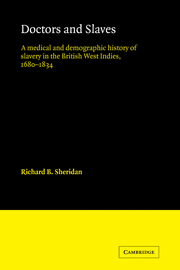 Doctors and Slaves
Doctors and Slaves Book contents
- Frontmatter
- Contents
- List of tables and figures
- Preface
- Acknowledgment
- 1 The disease environments and epidemiology
- 2 The medical profession
- 3 African and Afro-West Indian medicine
- 4 The Guinea surgeons
- 5 Slaves and plantations
- 6 Labor, diet, and punishment
- 7 Morbidity and mortality
- 8 The problem of reproduction
- 9 Smallpox and slavery
- 10 Slave hospitals
- 11 Plantation medical practice
- 12 Slavery and medicine
- Notes
- Bibliography
- Index
11 - Plantation medical practice
Published online by Cambridge University Press: 04 August 2010
- Frontmatter
- Contents
- List of tables and figures
- Preface
- Acknowledgment
- 1 The disease environments and epidemiology
- 2 The medical profession
- 3 African and Afro-West Indian medicine
- 4 The Guinea surgeons
- 5 Slaves and plantations
- 6 Labor, diet, and punishment
- 7 Morbidity and mortality
- 8 The problem of reproduction
- 9 Smallpox and slavery
- 10 Slave hospitals
- 11 Plantation medical practice
- 12 Slavery and medicine
- Notes
- Bibliography
- Index
Summary
The usual method of remunerating the medical man, if he be not attached to the property with a salary, is by paying him a dollar annually for every negro, whether sick or well, upon the estate which he attends; thus, if there be 300 negroes, he is paid 300 dollars, or 100l. currency per annum, for affording medical advice, the medicines being found by the proprietor. If the medical men form partnerships, and attend several properties, which is generally the case, their incomes become considerable.
H. T. De La Beche, 1825In our investigation of plantation medical practice, we look at the doctors and other white and black people who treated slaves in the British Sugar Colonies. More specifically, we are concerned with the extent of practice, the frequency of visits to slave hospitals, methods of procuring and dispensing medicines, and doctors' compensation. Among other things, the chapter contains case studies of individual doctors and comparisons with plantation medical practices in other slave societies.
The “irregular” practitioners
West Indian medical practice in the age of slavery developed from a system dominated by urban-based doctors who mainly treated white patients on an individual basis to a system of both urban- and rural-based doctors, with the latter treating chiefly black patients who were attached to estates and plantations on an annual contract basis. The shift from a predominantly white, urban-based practice to one directed chiefly to slaves attached to agricultural units can be explained, in part, by the near-monoculture system of sugar production.
- Type
- Chapter
- Information
- Doctors and SlavesA Medical and Demographic History of Slavery in the British West Indies, 1680–1834, pp. 292 - 320Publisher: Cambridge University PressPrint publication year: 1985
